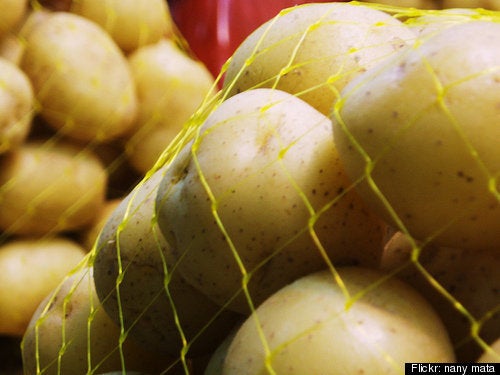
I distinctly remember cutting off sprouts before peeling potatoes when I was a child, but I have not seen a potato sprout in more than twenty years. Where did the sprouts go?
Potatoes, like apples, are typically harvested only once a year and then are stored in a cold storage facility until a grocer orders a shipment. In order to prevent potatoes from sprouting while they're in storage, growers spray them with an aerosol agent that regulates cell division. After being sprayed with the chemicals (typically chlorpropham or maleic hydrazide) potatoes arrive at the store looking perfect, unblemished, and without any sprouts for up to a year after harvest.
As you might expect, the chemicals that prevent cell division in potatoes impact human cell division too. The implications on human fertility and fetal organogenesis are just now being discovered. For this reason, Japan and the European Union have already placed strict limitations on the usage of anti-sprouting chemicals.
Non-toxic alternatives exist. In fact, a company in Israel called Pimi Agro Cleantech Inc. has developed a non-toxic, organic anti-sprouting agent that is just as effective as the synthetic alternatives. The catch is that until Pimi scales up production of their sprout suppressant, it costs $5 per ton, compared to $3 per ton for chlorpropham or maleic hydrazide. The difference sounds trivial, but in a nickels-and-dimes business like agriculture, the gap is insurmountable.
It is well-known that the food Americans eat is coated with chemicals whose long-term effects are not well understood. But what you may not know is that entrepreneurs and scientists around the world -- just like the people behind Pimi -- are developing promising new technologies that enable safer food production without compromising productivity.
Finding these companies and overcoming language and cultural barriers is a gargantuan task. But scouring the globe for these promising sustainable agriculture technologies is every bit as critical as finding obscure cancer therapies in the Brazilian rainforest.
I am happy to report that investors share my enthusiasm and determination. Interest in sustainable agriculture has skyrocketed, and investments in the sector have increased by 120% from 2000 to 2009. Agriculture 2.0TM, the conference series I created in 2009 to connect investors with sustainable agriculture entrepreneurs, has taken on a life of its own, and interested groups from India, China, and Europe have contacted me hoping to start similar dialogues in their home countries.
This September, Agriculture 2.0 Global Markets will take place in New York City bringing together investors and entrepreneurs from around the world. The objective is to catalyze and capitalize sustainable agriculture in global markets while highlighting corporate initiatives, technology, design, services, and advocacy in the sector.
Whether we like it or not, we are dependent upon synthetic chemicals at every link in the food chain, and eliminating them altogether is as fraught with difficulty as ending our dependence on fossil fuels. Our neighbors around the world are grappling with the same complex issues that we are. It is up to us to collaborate with them, to put the pieces together, and to rectify our food system.
For more information about the conference, visit www.agriculture20.com.